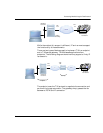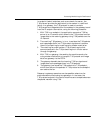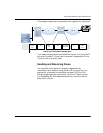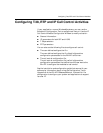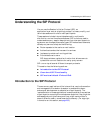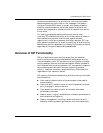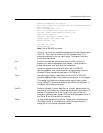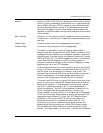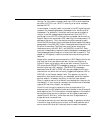
Understanding the SIP Protocol
November 2009 247
Overview of Operation
This section introduces the basic operations of SIP using simple
examples. This section is tutorial in nature and does not contain any
normative statements.
The first example shows the basic functions of SIP:
Locating an end point
Signaling a desire to communicate
Negotiating session parameters to establish the session
Tearing down the established session
Figure 20 on page 248 shows a typical example of a SIP message
exchange between two users, Caller A and Caller B. (Each message
is labeled with the letter “F” and a number for reference by the text.)
In this example, Caller A uses a SIP application on a PC (referred to
as a softphone) to call Caller B on the SIP phone over the internet.
Also shown are two SIP proxy servers that act on behalf of Caller A
and Caller B to facilitate the session establishment. This typical
arrangement is often referred to as the “SIP trapezoid” as shown by
the geometric shape of the dotted lines in Figure 20 on page 248.
Caller A “calls” Caller B using Caller B’s SIP identity, a type of
Uniform Resource Identifier (URI) called a SIP URI. It has a similar
form to an email address, typically containing a user name and a
host name. In this case, it is sip:callerb@biloxi.com, where biloxi.com
is the domain of Caller B's SIP service provider. Caller A has a SIP
URI of sip:callera@atlanta.com. Caller A might have typed in
Caller B's URI or perhaps clicked on a hyperlink or an entry in an
address book. SIP also provides a secure URI, called a SIPS URI. An
example would be sips:callerb@biloxi.com. A call made to a SIPS URI
guarantees that secure, encrypted transport (namely TLS) is used to
carry all SIP messages from the caller to the domain of the callee.
From there, the request is sent securely to the callee, but with
security mechanisms that depend on the policy of the domain of the
callee.
SIP is based on an HTTP-like request/response transaction model.
Each transaction consists of a request that invokes a particular
method, or function, on the server and at least one response. In this
example, the transaction begins with Caller A's softphone sending
an INVITE request addressed to Caller B's SIP URI. INVITE is an
example of a SIP method that specifies the action that the requester
(Caller A) wants the server (Caller B) to take. The INVITE request



